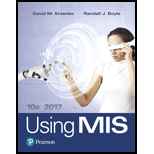
Explanation of Solution
Need of business professional to know about computer software:
The business professional must know about the various software components in order to manage the various resources which are discussed as follows:
Each computer has the operating system that are nothing but the computer programs used for the management of the various computer resources.
- The operating system plays an important role for the function of various system performances such as read operation, write operations and allocation of main memory and to perform the swapping of memory, responding to error and exception handling and to perform the backup, recovery of the resources.
- The operating system is also responsible for managing the various input and output devices such as the display, keyboard and mouse and to control other external devices.
- Software is needed for the maintenance of the functionalities of clients and server and it is necessary for the functioning of both the application of client and server.
- The application of the software can be useful in organization. The server operating system is the computer operating system that has been designed specifically for the configuration of server.
- The UNIX operating system can also be possible to implement on the servers. However the Linux operating system is also very useful in many organizations because it’s free and open source nature of the operating system and it’s easy to configure compared to the Microsoft server implementations.
Virtualization:
Virtualization can be defined as the process in which one computer system can appear as many computer systems. It is possible for one operating system that is known as host operating system to run as one or more operating system as the applications.
- The operating system that has been hosted is known as the Virtual machine where more than one operating system can be operated and each virtual machine can have their system resources allocated to it.
Types of virtualization:
There are three types of virtualization which are as follows:
PC virtualization:
- It is the process of virtually installing more than one operating system in a single personal computer.
- The user can be able to install more than one Operating System (OS) using some virtualization software such as VMware and both the OS can share the same system resources.
Server virtualization:
- The server virtualization is the process of hosting more than one server computer into a single server computer.
- The user can virtually host two virtual machines where each machine can act as server computer.
Desktop virtualization:
- The term desktop virtualization is the process of installing many operating systems for desktop in a single server...
Want to see the full answer?
Check out a sample textbook solution
Chapter 4 Solutions
Using MIS (10th Edition)
- Ensure you answer the question asked at the end of the document. Do not just paste things without the GNS3 console outputsarrow_forward"Do not use AI tools. Solve the problem by hand on paper only and upload a photo of your handwritten solution."arrow_forward"Do not use AI tools. Solve the problem by hand on paper only and upload a photo of your handwritten solution."arrow_forward
- "Do not use AI tools. Solve the problem by hand on paper only and upload a photo of your handwritten solution."arrow_forward"Do not use AI tools. Solve the problem by hand on paper only and upload a photo of your handwritten solution."arrow_forwardSolve this "Do not use AI tools. Solve the problem by hand on paper only and upload a photo of your handwritten solution."arrow_forward
- "Do not use AI tools. Solve the problem by hand on paper only and upload a photo of your handwritten solution."arrow_forward"Do not use AI tools. Solve the problem by hand on paper only and upload a photo of your handwritten solution."arrow_forwardSpecifications: Part-1Part-1: DescriptionIn this part of the lab you will build a single operation ALU. This ALU will implement a bitwise left rotation. Forthis lab assignment you are not allowed to use Digital's Arithmetic components.IF YOU ARE FOUND USING THEM, YOU WILL RECEIVE A ZERO FOR LAB2!The ALU you will be implementing consists of two 4-bit inputs (named inA and inB) and one 4-bit output (named out). Your ALU must rotate the bits in inA by the amount given by inB (i.e. 0-15).Part-1: User InterfaceYou are provided an interface file lab2_part1.dig; start Part-1 from this file.NOTE: You are not permitted to edit the content inside the dotted lines rectangle. Part-1: ExampleIn the figure above, the input values that we have selected to test are inA = {inA_3, inA_2, inA_1, inA_0} = {0, 1, 0,0} and inB = {inB_3, inB_2, inB_1, inB_0} = {0, 0, 1, 0}. Therefore, we must rotate the bus 0100 bitwise left by00102, or 2 in base 10, to get {0, 0, 0, 1}. Please note that a rotation left is…arrow_forward
 Fundamentals of Information SystemsComputer ScienceISBN:9781337097536Author:Ralph Stair, George ReynoldsPublisher:Cengage Learning
Fundamentals of Information SystemsComputer ScienceISBN:9781337097536Author:Ralph Stair, George ReynoldsPublisher:Cengage Learning Fundamentals of Information SystemsComputer ScienceISBN:9781305082168Author:Ralph Stair, George ReynoldsPublisher:Cengage Learning
Fundamentals of Information SystemsComputer ScienceISBN:9781305082168Author:Ralph Stair, George ReynoldsPublisher:Cengage Learning Principles of Information Systems (MindTap Course...Computer ScienceISBN:9781305971776Author:Ralph Stair, George ReynoldsPublisher:Cengage Learning
Principles of Information Systems (MindTap Course...Computer ScienceISBN:9781305971776Author:Ralph Stair, George ReynoldsPublisher:Cengage Learning Principles of Information Systems (MindTap Course...Computer ScienceISBN:9781285867168Author:Ralph Stair, George ReynoldsPublisher:Cengage Learning
Principles of Information Systems (MindTap Course...Computer ScienceISBN:9781285867168Author:Ralph Stair, George ReynoldsPublisher:Cengage Learning Enhanced Discovering Computers 2017 (Shelly Cashm...Computer ScienceISBN:9781305657458Author:Misty E. Vermaat, Susan L. Sebok, Steven M. Freund, Mark Frydenberg, Jennifer T. CampbellPublisher:Cengage Learning
Enhanced Discovering Computers 2017 (Shelly Cashm...Computer ScienceISBN:9781305657458Author:Misty E. Vermaat, Susan L. Sebok, Steven M. Freund, Mark Frydenberg, Jennifer T. CampbellPublisher:Cengage Learning





